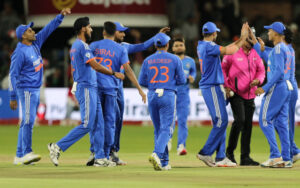
About six months before the ninth T20 World Cup, to be played in the West Indies and the United States, there are different signs. The national selectors, coaches and others involved in running the various formats have homed in on something and they are persisting with it. The outcome is a new approach. To borrow from football, they are playing a ‘pressing game’.
India lost two or three wickets inside six overs in both T20Is against South Africa. Led by Suryakumar Yadav and others like Yashasvi Jaiswal, Rinku Singh and Tilak Varma, they did not stop throwing the kitchen sink at the bowlers. It was not nonstop violence all the time. Yet, the enterprise and strategic thought to keep going was visible. There was always this emphasis on attack. Do it cautiously, if that makes sense, but do it.
There is a tendency to overlook this intent in bowling and fielding. That’s because the results are not as tangible as fours and sixes struck. This Indian team has shown a conscious desire to make things happen when they are on the field in both white-ball versions. Not often does one see something like a Mohammed Siraj beating the outside edge so many times and so comprehensively in a first over.
T20 Thrills will Define Suryakumar Yadav; not World Cup Failure
The captain was prompt in encouraging the bowler by deploying a third slip. This was the message. Thou shall attack with the bat in hand, the ball in the palm and when you charge at the ball while fielding. Do not give the opposition space to breathe. Stay ahead of the game once you have taken a firm first step. Bring on Kuldeep Yadav. Ask him to impart maximum revs on the ball.
That is what was missing in the Indian T20I teams of the last few years. They appeared conservative. With varied amounts of success and failure, England, Australia, West Indies, New Zealand and South Africa had identified resources and methods aimed specifically at this format. India were the sleeping giant. They knew what was happening, without being proactive when it came to structuring this particular set-up.
For the Latest Sports News: Click Here
There are big names missing at the moment. Equally unmistakable is the fact that those getting a chance are trying to execute something they know they are capable of. They also have the backing of the support staff. Jaiswal cuts early on after getting out to that shot for a duck. Varma gets out driving in the air first ball because a similar approach had paid off in the previous game. They are assured by the management that one failure will not cut short their journey.
This is not a revolutionary idea. It’s just that it’s new when it comes to India’s T20I thinking. The Suryakumar whips for sixes, the Jaiswal pulls, the Varma scoops, the fearless line of Siraj and the flighted ones from Kuldeep is not to be seen in isolation. They are happening concurrently with a certain role clarity explained to the players, a team vision, and a long-term goal. There is also a plan targeting specific objectives within a timeframe.
That is called staying ahead of the game. This may or may not pay dividends in the immediate future, but a much-awaited start has been made. The less they look back, the better.
Also Read: T20 Thrills will Define Suryakumar Yadav; not World Cup Failure




